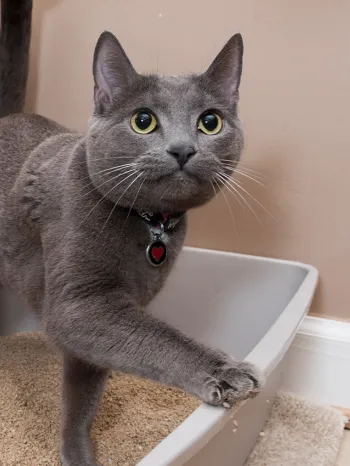If you’re welcoming a new kitten or helping an adult cat adjust, understanding their litter box habits is essential. While most cats instinctively know how to use a litter box, providing the right setup and maintaining a clean, safe environment is key to preventing accidents. From choosing the best litter box and litter type to handling common litter box problems, these expert-backed tips from cat behaviorist Matt Wildman will help keep your cat comfortable and your home fresh.
How Many Litter Boxes Do You Need?
The general rule is one litter box per cat, plus one extra, placed in different areas of your home. This ensures that every cat feels safe using a box without fear of being ambushed or bullied.
While it’s not realistic to assign a personal box to each cat, you’ll need to keep them clean and accessible at all times. Cats may avoid a box another cat has just used, so regular scooping is a must.
Choosing the Best Litter Box for Your Cat
When cats use a litter box, they want to feel safe, have room to move, and access easy escape routes if needed. A good litter box should be:
Large enough for your cat to turn around comfortably
Low enough for easy entry and exit
Placed in a quiet, low-traffic, but accessible location away from food and water
Experiment with different box types and sizes to see which your cat prefers.
Covered Litter Boxes: Pros and Cons
Covered boxes can help reduce litter scatter and odor, but they may also trap unpleasant smells inside and limit a cat’s visibility. This can make some cats feel vulnerable or trapped, especially if other cats are in the home. If your cat avoids a covered litter box, opt for an open one.
Self-Cleaning Litter Boxes: Are They Worth It?
While convenient for pet owners, self-cleaning litter boxes can be intimidating to some cats, especially those used to traditional boxes. If your cat seems hesitant, stick to what they know and feel comfortable with.
Top 15 cat tips
Sign up to receive our exclusive e-book full of important information about keeping your cat healthy and happy.
Best Types of Cat Litter
Cats tend to prefer fine-grained litter that mimics the texture of sand, reflecting their desert ancestry. Popular options include:
- Traditional clay litter
- Clumping litter
- Crystal or silica-based litter
- Plant-based or biodegradable litter
Some cats, especially those new to indoor living, may prefer soil or sand mixed with litter.
Once you find a litter your cat likes, stick with it. Changing litter types too often can lead to litter box avoidance.
Should You Use Scented Litter?
While scented litters mask odors for humans, they can be overwhelming for cats. Avoid strong scents and air fresheners near the litter box. A light layer of baking soda at the bottom of the box can help control odors without deterring your cat.
How Deep Should Cat Litter Be?
Most cats prefer about 2 inches of litter. Long-haired cats may even prefer less or a smooth surface. Adding more litter won’t reduce the need for daily cleaning.
Are Litter Box Liners a Good Idea?
Though convenient for pet owners, litter box liners often catch on a cat’s claws, making them uncomfortable. Many cats will avoid boxes with liners, so it’s best to skip them.
Best Places to Put a Cat Litter Box
The right litter box placement can make a big difference in your cat’s bathroom habits. While it’s tempting to hide litter boxes in out-of-the-way places, avoid spots that feel unsafe or uncomfortable for your cat.
Placement tips:
- Choose quiet, low-traffic areas that are easy for your cat to access
- Avoid placing boxes near loud appliances like washers, dryers, or furnaces
- Keep litter boxes far from your cat’s food and water bowls
- Provide at least one litter box per floor in multi-level homes
If placing in a closet or bathroom, make sure your cat can easily get in and out.
How Often Should You Clean a Cat’s Litter Box?
Scoop waste daily to maintain a clean, inviting litter box. How often you replace the litter depends on the number of cats, the number of boxes, and the litter type:
- Clay litter: Replace twice a week
- Clumping litter: Replace every 2–3 weeks if scooped daily
- Change sooner if you notice odors or wet, clumped areas
Each time you replace the litter, wash the box with mild dish soap. Avoid products with ammonia, citrus oils, or harsh chemicals, as these can repel cats and may be toxic.
Why Cats Stop Using the Litter Box (and What to Do)
If your cat suddenly stops using the litter box, it’s a sign something’s wrong — either medically, behaviorally, or environmentally.
Common causes include:
- Dirty or poorly placed litter boxes
- Changes in litter type or box style
- Stress or territorial conflicts with other pets
- Medical issues like urinary tract infections or arthritis
Your first step should always be a vet check-up to rule out health problems. If your cat gets a clean bill of health, evaluate the litter box setup and address potential stressors.
Avoid punishment. Cats aren’t acting out of defiance but are trying to meet their needs. If problems persist, consult a certified cat behaviorist.
Final thoughts
Creating a cat-friendly litter box setup and maintaining a clean, safe environment are the keys to preventing accidents and keeping your cat healthy and happy. Pay attention to your cat’s preferences and habits — and when in doubt, consult your veterinarian or a feline behavior expert.



